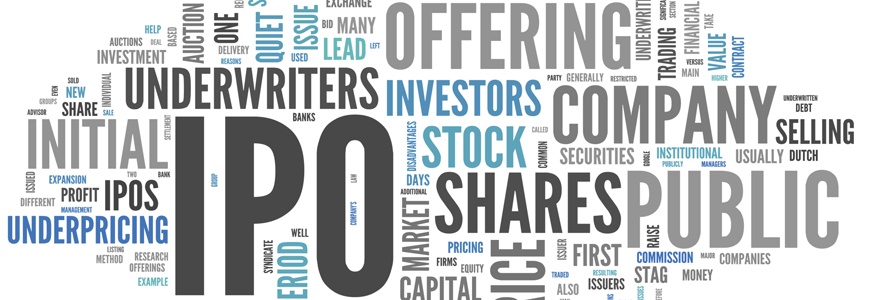What to Know Before IPO
1 May, 20208 Things to Consider Before Filing an IPO
According to a Wall Street Journal article, signs are mounting that the moribund IPO market is gaining some momentum. The article cites that investors have shown “intense interest” in new shares that have come to market recently, especially in the tech sector. Bankers who market IPOs for a living, and investors who buy them, say such performance from a key sector sets up the overall IPO market for a rebound in 2017.
 At a time when the economy remains sluggish, that’s good news. It may also be good news for companies considering an IPO, because in a torpid economy investors are more likely to pay higher multiples for a strong growth prospect.
At a time when the economy remains sluggish, that’s good news. It may also be good news for companies considering an IPO, because in a torpid economy investors are more likely to pay higher multiples for a strong growth prospect.
But how do you know if your company is ready to go public?
The process for filing an IPO is time-consuming and expensive and should not be entered into lightly. And sometimes, companies that are doing wonders before being launched on the stock exchange suddenly enter a death spiral—think Facebook, Vonage and Pets.com.
Here are 8 things to evaluate before considering taking your company public:
#1 Is an IPO even feasible?
 According to Sigma Prime Ventures[1], an investment firm based in Boston, the first thing any company should consider when thinking about an IPO is whether an IPO is even feasible. To determine the answer to that question, they recommend that four criteria be examined:
According to Sigma Prime Ventures[1], an investment firm based in Boston, the first thing any company should consider when thinking about an IPO is whether an IPO is even feasible. To determine the answer to that question, they recommend that four criteria be examined:
- First, how big is the market and how fast can you grow? The bigger the market, the more money you can make and the more money you can make the faster you can grow. If your company has a huge market and room to grow, you’re a fourth of the way there.
- Second, how disruptive is your product? Is your product a new way of doing something? The more disruptive your product is, the better. You want to stand out, you want to be new, and you want to change the way things are done.
- Third, how predictable is the business model? If you can accurately predict how you will do in the future, whether quarterly or yearly, you have a huge advantage. Public market investors love quality, predictable earnings. If you can prove to investors your company will succeed, investors will buy your story, but more importantly, your stock.
- And fourth, how much leverage do you have? What gives your company a competitive advantage? What asset does your company control that lets it gain more leverage over rivals as you grow? If you’ve got a real advantage, then you have the final solution to the IPO equation.
#2 What’s your value narrative?
Wall Street investors will want to know your company’s story, so you need to be ready to tell it. They’ll want to know your growth prospects and the kind of numbers you're going to produce. They're also going to want to know what you offer that your competitors don't, and what your long-term strategy is. Familiarize yourself with how your competitor’s shares, once they’ve gone public, have performed and learn from those experiences. According to Arlene Weintraub, in an article in Entrepreneur,[2] the most important factor when considering going public is to determine up front whether Wall Street investors will be open to hearing your company's story.
 #3 Is your board of directors in good shape?
#3 Is your board of directors in good shape?
There are a number of regulations that require that public companies have a majority of board members who are independent of the company. An “independent director” is one who the board affirmatively determines has no “material relationship” with the company either directly or as a partner, shareholder or officer of an organization that has a relationship with the company.[3] Keep in mind that after going public, a board is reflecting the interests of shareholders, as well as of the business, so it’s critical that they are unbiased and independent enough from the company in order to ask the hard questions.
Other factors to consider are whether the board of directors is the appropriate size for the company and if board committees have been established and charged with particular tasks, such as auditing and compensation.
Many experts suggest that the process of identifying and recruiting new board members should commence at least a year before filing for an IPO.
#4 Is your financial staff up to snuff?
Once public, the Security & Exchange Commission (SEC) requires that the company file quarterly and annual reports, as well as other periodic reports. In addition to annual financial reports, company executives must provide a narrative account, called the Management Discussion and Analysis (MD&A) that outlines the previous year of operations and explains how the company fared in that time period. MD&A will usually also touch on the upcoming year, outlining future goals and approaches to new projects. This public reporting is crucial for investors to make sound decisions when investing in the capital markets.
Because of the complexity of the SEC’s reporting requirements, IPO experts will usually recommend hiring a general counsel and an investor-relations specialist with experience in SEC reporting. And, if you plan to offer stock options to employees, you may need to hire human resources professionals with experience putting together benefits packages that include stock.
#5 Have you weighed the risks and benefits?
 There are both risks and benefits associated with taking a company public. Before filing an IPO, the risks and benefits should be assessed.
There are both risks and benefits associated with taking a company public. Before filing an IPO, the risks and benefits should be assessed.
Benefits
The benefits of going public include an infusion of cash derived from the sale of stock. This enables a company to grow the business without having to borrow from traditional sources and avoid paying interest to service debt. This “free” cash can be spent on marketing and advertising, hiring more experienced personnel who require lucrative compensation packages, research and development of new products and services, new construction and dozens of other programs that expand the business and improve profitability.
Stock can also be used as an effective incentive program for recruiting talented senior management personnel. For employees, a performance-based program of stock and or option bonuses is an effective means of increasing productivity and managerial successes.
Also, a publicly traded company conveys a positive image and may have more leverage when negotiating with vendors, thus reducing costs. Customers also usually have a better perception of companies with a presence on a major stock exchange.
Risks
The downside to filing an IPO is that, once public, all of the company’s finances and business operations are open to government and public scrutiny, which can sometimes be perceived as less than ideal. Once public, the company is subject to SEC oversight and regulations and all the reports that entails.
Additionally, board pressure for profitability each quarter can be a difficult challenge for the senior management team. Failure to meet target numbers or forecasts often results in a decline in the stock price.
Lastly, remember that preparation for the IPO is expensive, complex and time consuming. Lawyers, investment bankers and accountants are required, and often, outside consultants must be hired. As much as a year or more may be required to prepare for an IPO, and during this period, business and market conditions can change radically enough to change the decision about going public, thus rendering all the preparation work and expense wasted.
#6 Is it wise to “test the waters”?
 In April of 2012, President Obama signed into law the Jumpstart Our Business Startups (JOBS) Act. Title IV of the JOBS Act not only raised the threshold for dollar amounts that smaller companies could raise, but also provided a provision for companies to “test the waters.” This provision essentially allows companies to file their IPOs in stealth mode, get feedback from the SEC, and then conduct meetings with potential investors before the official “road show” all companies have before going public. It's an opportunity to determine whether an IPO is a good idea, without tipping your hat to competitors and without the pressure of making all your corporate information public.
In April of 2012, President Obama signed into law the Jumpstart Our Business Startups (JOBS) Act. Title IV of the JOBS Act not only raised the threshold for dollar amounts that smaller companies could raise, but also provided a provision for companies to “test the waters.” This provision essentially allows companies to file their IPOs in stealth mode, get feedback from the SEC, and then conduct meetings with potential investors before the official “road show” all companies have before going public. It's an opportunity to determine whether an IPO is a good idea, without tipping your hat to competitors and without the pressure of making all your corporate information public.
#7 Are you prepared for the “road show”?
A road show is a presentation of securities an issuer makes to potential buyers. A company assembles a team of executives to travel around the country and present to large groups of institutional or big money investors. The goal is to portray the company as profitable and progressive and to generate excitement and interest in its offering. But the presentations must be factual and they can only be held after a company registers its intentions to sell securities with the SEC. Road shows contain details about a company’s financial outlook, its reasons for an IPO, the probable sale price and its potential for growth. Today, many companies hold road shows online and some may hold private meetings with investors before the offering.
The road show is a vital step in the IPO process because it may be the first and only time investors meet your company’s senior management face to face. And since institutional investors rarely visit the companies they invest in, they rely heavily on the information you present at your road show meetings. In fact, an EY study found that the strong majority (82%) of institutional investors worldwide cite the quality of the road show as a key non-financial measure in their buying decisions.
#8 Have you considered the alternatives?
Sometimes the cost of going public and the burdens of SEC reporting make the IPO process too daunting. According to the Wall Street Journal,[4] many companies today are losing the urge to go public, despite a buoyant stock market, choosing instead to be acquired by corporate or private-equity suitors. In some cases, they fear that having to answer to a diverse crowd of public shareholders each quarter—as opposed to a few private-equity executives—would prevent them from deploying capital quickly or from focusing on long-term goals.
 Indeed, there is plenty of nonpublic money available. According to data provider Preqin, private-equity funds currently have over $1.46 trillion in uninvested capital. That’s up from $1.39 trillion at the end of 2015. And with large public companies looking to grow through acquisitions, many companies have decided that the best exit plan might be a sale.
Indeed, there is plenty of nonpublic money available. According to data provider Preqin, private-equity funds currently have over $1.46 trillion in uninvested capital. That’s up from $1.39 trillion at the end of 2015. And with large public companies looking to grow through acquisitions, many companies have decided that the best exit plan might be a sale.
For many companies, going public is a perceived natural path to success and a beautiful means of making money. But with so many IPO disappointments, it’s important for CEOs to enter into the process vigilantly and to learn from industry experts, such as iBankers, legal advisors and competitors. Providing all the pros and cons have been understood and evaluated, and all the inherent risks assessed, if circumstances are right, an IPO may open profitable new opportunities for a company ready to be publicly traded.
[1] http://www.sigmaprime.com
[2] https://www.entrepreneur.com/article/227487
[3] https://en.wikipedia.org/wiki/Independent_director
[4] http://www.wsj.com/articles/companies-embrace-ipo-alternatives-1479169231
